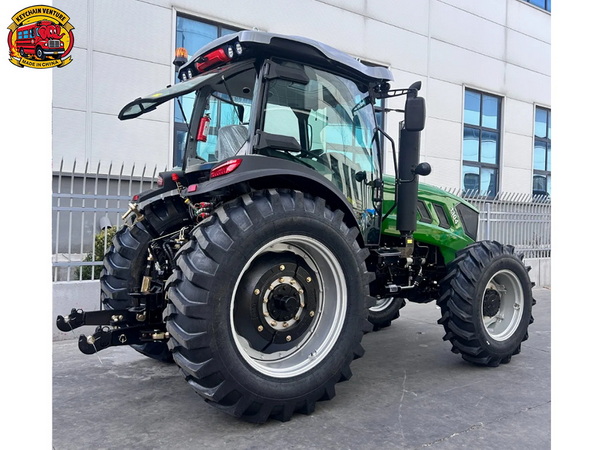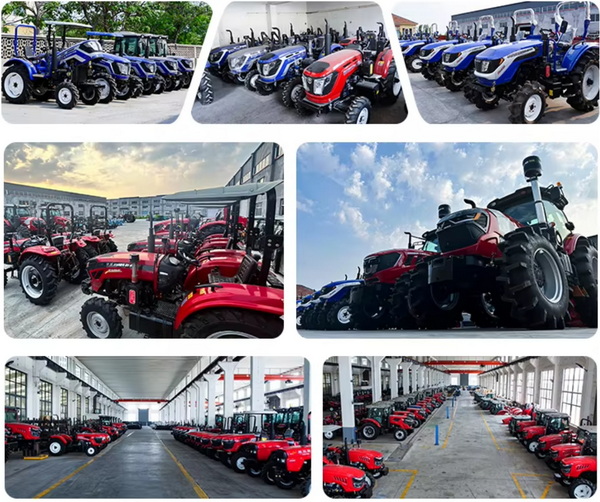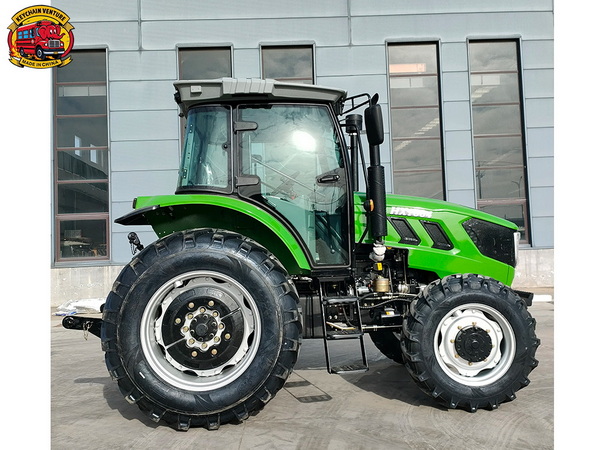Views: 222 Author: Amanda Publish Time: 2025-10-25 Origin: Site








Content Menu
● Why Used Tractor Evaluations Are Crucial
● Essential Preparation for Used Tractor Inspection
● Step-by-Step Evaluation Process
>> Exterior and Structural Assessment
>> Engine Compartment and Fluid Levels
>> Battery and Electrical Systems
>> Hydraulic System Evaluation
>> Transmission and Drivetrain Testing
>> Cabin, Controls, and Comfort
>> Safety Features and Accessories Review
>> Attachments and Compatibility
● Advanced Used Tractor Inspection Techniques
>> Maintenance Records and Ownership Verification
● Common Problems in Used Tractors
● Daily and Periodic Inspection Checklist
● Professional Inspection and Test Drive
● Legal and Document Review for Used Tractors
● Final Recommendations: Buying with Confidence
● FAQs
>> 1. What are the first things to check when inspecting a used tractor?
>> 2. How can I check a used tractor's engine condition?
>> 3. Why are maintenance records important in a used tractor purchase?
>> 4. What are common problems faced with used tractors?
>> 5. Is it safe to buy a used tractor with high operating hours?
Purchasing a used tractor remains one of the most critical decisions for farmers, construction companies, and landowners who aim to balance cost with reliable performance. Unlike new machinery, a used tractor requires diligent inspection to safeguard your investment and ensure years of reliable service. This guide arms you with a thorough, actionable evaluation process rooted in best practices and expert insights.[10][11][12][13]

Tractors serve as the backbone of agricultural and construction operations. Choosing a poorly maintained or mismatched used tractor can lead to financial setbacks, operational delays, and safety hazards. A careful, step-by-step approach reduces risk, captures hidden issues, and gives peace of mind as you move toward final purchase.[14][15][16]
Before evaluating any used tractor, organize the following:
- Bring a notepad and detailed checklist for technical observations and questions.
- Have basic mechanical knowledge, or bring a trusted expert.
- Schedule daylight inspections for optimal visibility.
- Request all documentation in advance, including maintenance logs and proof of ownership.[17][18][19][14]
Begin with a slow, comprehensive walk-around. Look out for:
- Rust, dents, scratches, or paint chips indicating age and prior repairs.
- Welds on the frame or attachments suggesting repair work.
- Visual stress points, especially near ROPS (Rollover Protective Structure).
- Check all attached implements for fit and wear.[5][13][20]
Tires contribute significantly to effective operation and overall safety. Inspect for:
- Proper tire inflation for tractor stability.
- Sufficient tread depth; uneven wear suggests mechanical alignment issues.
- Cuts, bulges, or punctures, and tight wheel nuts.
- Wheel rim condition (rust, bends, cracks).[1][3][6][7]
Bad tires or poorly maintained wheels can result in hazards and unexpected repair costs.
The engine is the tractor's powerhouse. Check:
- Oil level and color—dark or gritty oil signals overdue changes.
- Coolant and hydraulic fluid levels for signs of leaks, foam, or discoloration.
- Air filter cleanliness—dirty filters reduce efficiency and cause premature wear.
- Presence of excessive oil, fuel, or coolant beneath the tractor.[3][6][7][1]
Thorough fluid checks reveal how the previous owner maintained the equipment.
Routine battery and electric system evaluation improves reliability. Examine:
- Battery mount integrity and terminal cleanliness.
- Proper electrolyte levels and no signs of corrosion.
- Functionality of all external lights, flashers, and dashboard indicators.
- Inspect for frayed wires, exposed connections, or faulty switches.[6][21][1]
Tractors often rely on hydraulic power for vital functions. Test:
- Hydraulic fluid levels and absence of foaming or contamination.
- Responsive hydraulics when cycling attachments.
- Examine hoses and connections for cracks or leaks.
- Inspect hydraulic cylinders for smooth motion and non-leaking seals.[12][22][3][6]
Used tractors' transmission systems must function reliably under load. Verify:
- Smooth shifting in all ranges.
- Clutch action—no slippage, vibration, or odd noises.
- PTO engagement: test with multiple speeds.
- Responsive brakes and steering, including emergency shutdown mechanisms.[9][20][3]
User comfort enhances productivity. Assess:
- Seat integrity and adjustment, safety belt function.
- Control levers and pedals—free movement, no excessive play, or sticking.
- Visibility from the operator's seat; check that mirrors and windows are clean and properly aligned.
- Gauges, indicator lights, and switches—all operational.[3][5][6]
Safety is paramount. Inspect the following:
- SMV (Slow Moving Vehicle) emblem: clean and visible.
- Shields are fitted, undamaged, and in place.
- ROPS firmly attached, zero stress points or cracks.
- Emergency shut-off mechanisms, fire extinguisher, and first-aid kit status.[4][7][1][3]
Ensuring all safety features work reduces risk during operation.
Evaluate each attachment for compatibility and condition:
- Secure fitment to the tractor's mounting and hitch points.
- Guards and lock mechanisms fully functional.
- Inspect moving parts of each implement—replace worn or missing guards before use.
- Hydraulic connection points clean, undamaged, and compatible.[7][23][5][17]

For expert reviews, consider deeper inspection beyond the basics:
- Compression test for engine cylinders.
- Oil sample analysis to reveal hidden problems.
- Transmission fluid sample.
- Evaluate camshaft, lifters, pushrods, and exhaust system integrity.[9][3]
Consider hiring a certified mechanic for these checks before final negotiations.
Request and review:
- Maintenance logs, including dates, types of service, and technicians involved.
- Repair history, especially for major engine, transmission, or hydraulic issues.
- Confirm tractor's operational hours versus age; lower hours may indicate less wear.[18][19][17]
- Ownership and registration documentation.
- Investigate if any remaining manufacturer's or dealer's warranties apply.[16][14]
Understanding what typically goes wrong helps you guard against unexpected repairs:
- Hard or failed starting (battery, fuel, ignition problems).
- Overheating from poor coolant flow or dirty radiator.
- Hydraulic leaks, including slow actuator response.
- Transmission faults—slipping, rough shifting, noise.
- Electrical faults (lights, gauges, starter).[21][22][24]
Consistent inspections yield ongoing rewards in safety and operation. Use the following as a guideline:
- Fluid levels: engine oil, hydraulic, coolant, fuel.
- Visual check for leaks under tractor.
- Tires: pressure, tread, condition.
- Battery: mount, connections, electrolyte.
- General body: cracks, broken parts, shield position.
- Lights/flasher: walkaround test.
- Mirrors/windows: cleanliness and alignment.
- Controls: smooth operation, no sticking.
- Brake, steering: full function.
- Safety equipment: SMV, ROPS, shut-off mechanisms.[1][5][6][7][3]
Integrate this checklist as part of your regular operational routine for maximum value.
Request a certified mechanic's assessment for large or high-value tractors. On test drives:
- Assess startup, idling, and running performance.
- Test under load and with multiple attachments.
- Confirm comfort, ergonomic control operation, and visibility.
- Listen for any knocking, rattling, or whining—these can pinpoint hidden issues.[15][20][25][12]
Validate all legal documents, ensuring:
- Current title and registration.
- Bill of sale with accurate transfer of ownership.
- Dealer certifications if applicable.
- Clear history of warranties or recalls.[14][16]
Proper documentation streamlines ownership and protects your rights.
After comprehensive checks and test drive, consider:
- Price comparison with similar used tractors, accounting for your findings.
- Resale value and ease of future maintenance.
- Dealer or seller reputation and post-sale support.
- Negotiation points for defects or upcoming service needs.
- Post-purchase insurance and upkeep planning.[10][12][17][14]
Evaluating a used tractor demands discipline, technical insight, and methodical assessment. Combining exterior, mechanical, safety, and documentation checks guarantees a sound investment, reduces risk, and ensures a solid operational future for your farm or business. Thorough preparation, expert consultation, and careful test-driving are key. Applying these strategies positions you for successful ownership, providing value and peace of mind over the long haul.[11][13][16][10][14]

Start by assessing the body for damage and rust, then check fluid levels, tires, and battery health for signs of neglect or improper maintenance.[5][1]
Listen for abnormal noises after starting, look for smoke, and verify stable oil pressure; deeper engine tests may require a mechanic.[23][3][9]
Maintenance logs reveal the care level and predict future repairs, ensuring no major breakdowns are likely to occur soon.[19][17][18]
Common problems include poor starting, hydraulic leaks, electrical faults, transmission issues, and overheating due to poor maintenance.[22][24][21]
High hours suggest more wear and potential for repairs, but detailed service history and good care can offset risks for reliability.[15][18][14]
[1](https://ehs.msu.edu/occ/tractors/tractor-inspection-checklist.html)
[2](https://casa-acsa.ca/wp-content/uploads/CASA-Tractor-Pre-Use-Checklist-ENG-FINAL.pdf)
[3](https://cropilots.com/tractor-maintenance-checklist-2024/)
[4](https://heavyvehicleinspection.com/checklist/post/John-Deere-Tractor-Safety-Checklist)
[5](https://lumiformapp.com/templates/tractor-inspection-checklist)
[6](https://www.teamtractor.com/blog/tractor-daily-inspection-checklist--63511)
[7](https://www.getmaintainx.com/procedures/d/bUCej969f1o/tractor-pre-operational-inspection-checklist)
[8](https://www.fieldex.com/en/checklist/tractor-maintenance-checklist)
[9](https://tractoraddict.com/keeping-your-farm-tractor-in-tip-top-shape-comprehensive-maintenance-checklist-17-service-items/)
[10](https://www.prioritytractor.com/blog/a-comprehensive-guide-to-buying-a-used-tractor--98941)
[11](https://solisworld.com/blog/used-tractor-buying-checklist-guide/)
[12](https://www.agrivisionequipment.com/blog/tips-for-buying-a-used-tractor--74733)
[13](https://www.tractor-ranch.com/blog/correctly-evaluating-a-used-tractor)
[14](https://www.fbfs.com/learning-center/how-to-buy-a-used-tractor)
[15](https://nelsontractorco.com/10-things-to-know-before-buying-a-used-tractor/)
[16](https://www.machinefinder.com/ww/en-US/buyers-guides/tips-for-buying-a-used-tractor)
[17](https://www.atlantictractor.net/blog/key-questions-to-ask-when-buying-a-used-tractor--99776)
[18](https://www.westhillstractor.com/blog/questions-to-ask-when-buying-a-used-tractor-for-your-farm--100698)
[19](https://agandturf.unitedequip.com/news-and-events/faq-a-tractor-buyers-guide/)
[20](https://blog.rbauction.com/inspection-tips-what-to-inspect-before-buying-a-used-farm-tractor/)
[21](https://www.recoequip.com/blog/tractorscommon-problems--solutions--21529)
[22](https://www.arizonatractorsales.com/blog/common-tractor-problems-and-how-to-fix-them--77374)
[23](https://extension.psu.edu/buying-a-used-tractor/)
[24](https://www.fmiequipment.com/blog/tractor-problems-and-solutions--28810)
[25](https://www.youtube.com/watch?v=7X15T3hDwC8)